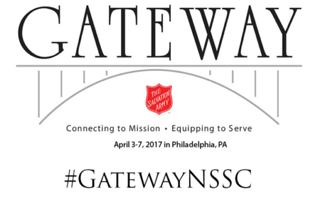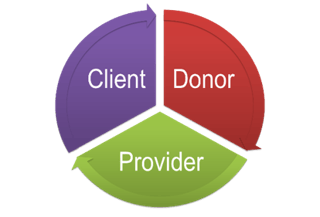
What You Need to Know from the Gateway 2017 Conference
 My colleagues and I recently attended the 2017 National Social Services Conference in Philadelphia, Pennsylvania, from April 3–7.
My colleagues and I recently attended the 2017 National Social Services Conference in Philadelphia, Pennsylvania, from April 3–7.
What an experience! The conference, appropriately themed “Gateway,” put The Salvation Army’s mission front and center with a full schedule of critical programming, information-sharing, and fellowship that served as an impactful reminder of the work done — day in, day out — in communities where we live and work.
We were conference participants and exhibitors, but more importantly, we were there to listen and learn. Here are a few of my observations from the week:
- Program staff work hard — and the work being done is getting harder every day. The demand for services continues to increase, and that demand outpaces the limited resources available. Program staff are having to do more with less.
- The tenets of the social service model parallel the donor-commitment model used in fundraising. The ways in which we reach, relate, engage, connect, assess, and report to our various clients are similar. We may use different terminology and illustrate our approaches differently, but we have similar goals — from identifying populations (donors), to providing solutions (offers), to creating positive outcomes (revenue). In fact, during one session about using data to measure outcomes in Pathways of Hope, the speaker shared the following: Assessments are used as a basis for identifying problems, planning interventions, evaluation and/or diagnosing clients, and informing clients and stakeholders. This mirrors our insight-driven approach to building a fundraising program and creating positive donor relationships.
- Don’t forget the donor.
 From William Booth’s first fundraising letter, the donor was part of the Army’s mission. Donors support you because they need to. It’s part of the human condition. Every person we spoke to at the conference had a story to share — of a client helped, a program launched, and (when asked), what an increase in resources would mean for one of their programs. But many of these same people had little awareness of what their fundraising colleagues did, and how they could work together to support their respective goals.
From William Booth’s first fundraising letter, the donor was part of the Army’s mission. Donors support you because they need to. It’s part of the human condition. Every person we spoke to at the conference had a story to share — of a client helped, a program launched, and (when asked), what an increase in resources would mean for one of their programs. But many of these same people had little awareness of what their fundraising colleagues did, and how they could work together to support their respective goals.
How do we bridge the gap between program and donor, and connect donors to our mission? Through the fundraising stories we tell!
The most successful fundraising moves the donor relationship forward — from transactional giving relationships to deeper, more committed relationships. Sustainer donors are a good example of this, or when a donor becomes an ambassador for your mission. While there’s a lot of science behind effective storytelling, there are three “types” of stories that connect donors to your mission.
- Impact stories Great storytelling isn’t about stats. It’s about seeing and hearing how a donor’s gift was used. Donors support your mission based on the belief that you’ll do good. But stories that show how their support makes a difference will take the relationship to a new level.
Storytelling exercise: Ask any program staff member to share a recent success story that they are most proud of and why? Their answer is an impact story.
- Donor-first stories Too often, organizations talk about themselves — their needs, their events, their goals — and often, they don’t involve the donor as part of the solution. An institution-first approach creates a barrier between the donor’s need to give and the organization’s need for help. By involving the donor, your success becomes a shared goal.
Storytelling exercise: Review a recent donor communication, and circle the words where you talk about yourself or the organization (I, we, our, etc.) in RED. Then circle the times you mention the donor (you, your, etc.) in BLUE. Your fundraising messages are donor-first if you find more blue than red. - First-person (client) stories This is where your program staff can tap into a deep well of knowledge. The most powerful stories are those first-person accounts from someone who was helped by your organization. The stories come from their perspective, not yours, and are completely authentic and real.
Storytelling exercise: Identify a person or family that has a story you think may be worth sharing. Ask them to write a letter (or you can record them) telling their story. Don’t worry about style or grammar or flow — just have them tell their story in their own words.
If you do nothing else, make sure that your development and program staff talk often. It’s the best reminder of what’s important to both groups, and you’ll often find creativity and inspiration for your next story.
Ready to take your storytelling to the next level? Check out our FREE How-To Storytelling Guide.
No other social service organization in the world has the history, reach, and diversity of The Salvation Army. Every day, we work collaboratively with our clients to identify fundraising stories that connect donors to the amazing work being done by your organization. If you are interested in talking more about how to use storytelling to connect with donors to raise more funds, let us know.
